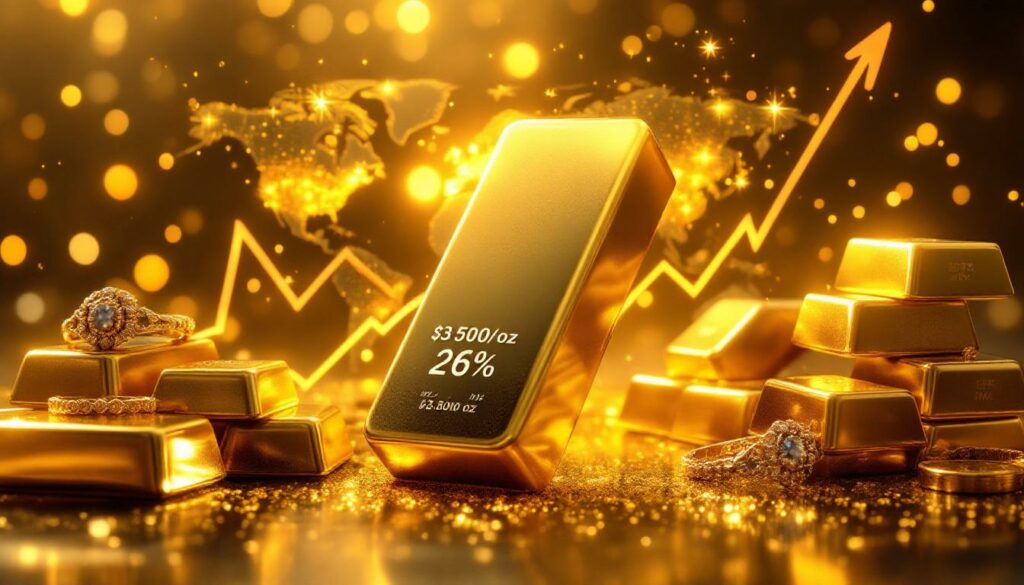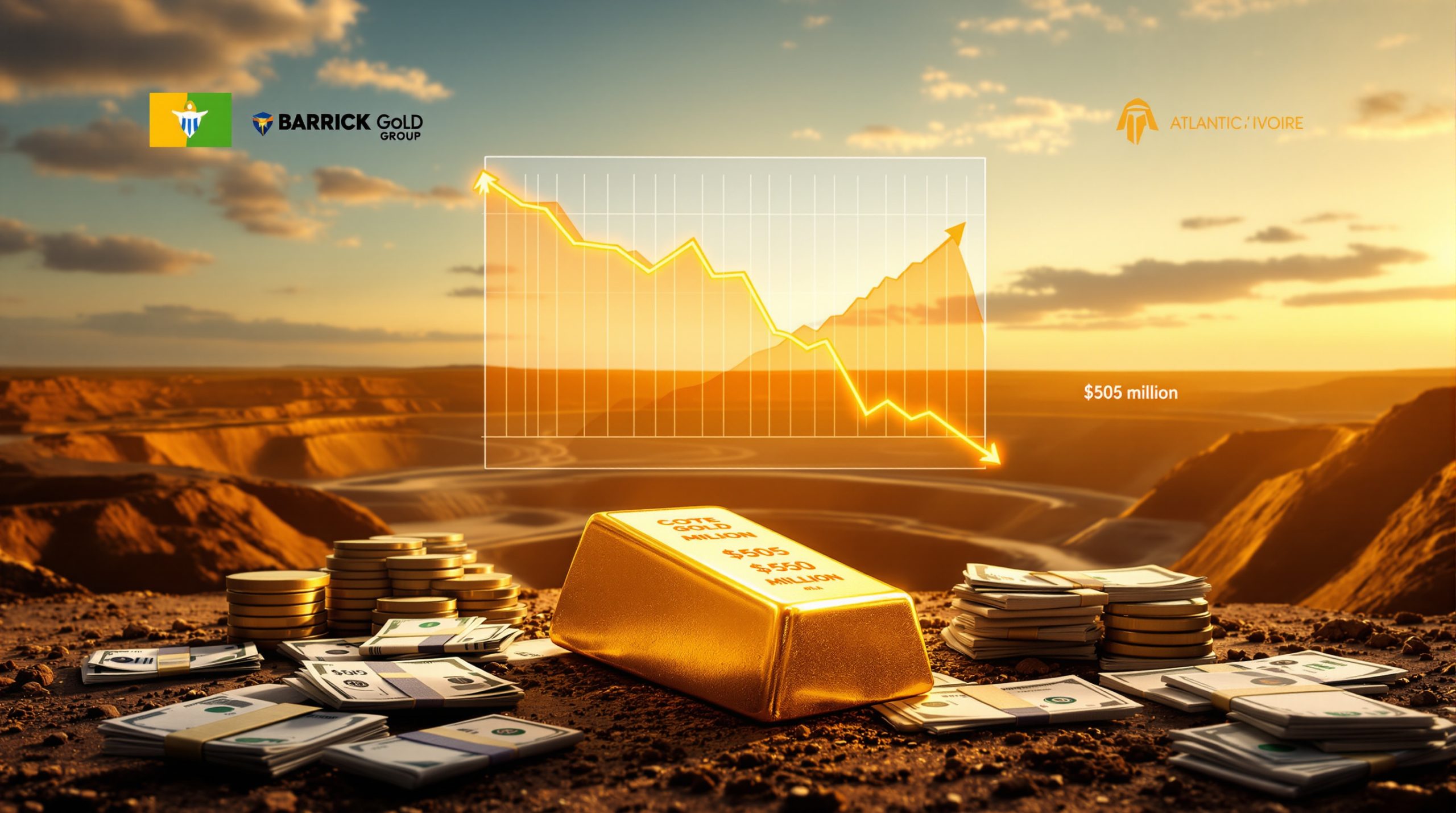What Factors Are Driving the Recent 3% Increase in Global Gold Demand?
Understanding the 2025 Gold Market Surge
Gold demand has shown remarkable resilience with a 3% year-on-year increase to 1,248.8 metric tons in Q2 2025, according to the latest World Gold Council data. This growth comes despite all-time high gold prices analysis, highlighting the complex interplay between investment appetite and traditional consumption patterns.
Record-Breaking Price Performance
- Gold reached an unprecedented $3,500 per troy ounce in April 2025
- Overall price appreciation of 26% since January 2025
- Total global demand including OTC trading reached 1,248.8 metric tons in Q2 2025
- Investment demand surged by 78% year-on-year in Q2 2025
The World Gold Council notes that this price surge represents the strongest bull market since 2020, with the metal breaking through multiple psychological barriers in quick succession during Q1 and Q2.
Macroeconomic and Geopolitical Catalysts
- Heightened global trade policy uncertainties creating market volatility
- Ongoing geopolitical tensions driving safe-haven asset flows
- Investors seeking alternatives to traditional currency-based investments
- Shifting central bank reserve strategies influencing market sentiment
"The perfect storm of factors including international trade frictions and persistent inflationary pressures has created an environment where gold as an inflation hedge appeal is magnified," explains the World Gold Council in their latest quarterly report.
How Are Investment Patterns Reshaping the Gold Market?
The most striking feature of the Q2 2025 gold demand landscape is the dramatic divergence between investment and consumption patterns. While investment vehicles show remarkable growth, traditional physical consumption faces headwinds from record prices.
ETF and Physical Investment Trends
- Gold ETFs experiencing their strongest semi-annual inflow since H1 2020
- Continuous ETF inflows for 11 consecutive months through July 2025
- Gold bar demand increased by 21% in Q2 2025
- Contrasting decline in gold coin interest despite overall investment growth
- World Gold Council projecting continued ETF strength through H2 2025
This sustained ETF inflow streak represents a fundamental shift in how institutional investors view gold's role in modern portfolios. The WGC notes that "Gold ETFs have further upside potential in the second half of the year," suggesting this trend has staying power.
Central Bank Purchasing Dynamics
- Central bank acquisitions decreased by 21% to 166.5 tons in Q2 2025
- WGC revised downward its forecast for 2025 central bank purchases
- Long-term strategic shift from US assets toward gold reserves remains intact
- Combined official and estimated unofficial purchasing remains significant
Despite this quarterly reduction, the WGC emphasizes that central banks continue their strategic diversification away from US dollar assets toward gold, representing a structural shift rather than cyclical behavior. The reduction appears to be a timing issue rather than a reversal of strategy.
Why Is Traditional Gold Consumption Declining While Investment Surges?
The disconnect between robust investment demand and weakening traditional consumption highlights gold's dual nature as both luxury good and financial asset.
Jewelry Market Transformation
- Global jewelry demand contracted by 14% to 341.0 tons in Q2 2025
- Lowest jewelry consumption level recorded since Q3 2020
- China and India's combined market share fell below 50% (rare occurrence)
- Record prices deterring traditional buyers in key consumption markets
This dramatic reduction in jewelry demand demonstrates the price sensitivity of traditional gold consumers. As the World Gold Council noted, "When gold crosses certain price thresholds, discretionary jewelry purchases face significant headwinds, particularly in price-sensitive markets."
Regional Consumption Shifts
- Major consumption declines concentrated in Asian markets
- Indian consumers increasingly exchanging old jewelry rather than selling
- Growing trend of using gold as loan collateral in certain markets
- Varied regional responses to historically high price environment
Cultural factors play a significant role in how different regions respond to high gold prices. In India, the WGC identifies a growing trend where consumers prefer to exchange existing gold items for new ones rather than selling outright, reflecting gold's cultural significance beyond mere investment value.
How Is the Supply Side Responding to Changing Market Dynamics?
The supply response to record prices has been surprisingly muted, defying traditional economic expectations that high prices stimulate increased recycling activity.
Recycling and Production Adjustments
- Gold recycling increased by only 4% to 347.2 tons in Q2 2025
- Recycling activity relatively modest despite record-high prices
- Indian market showing preference for jewelry exchange over outright selling
- Evolving supply chain adaptations to shifting demand patterns
The modest recycling response challenges conventional market wisdom that high prices automatically trigger significant selling. The WGC attributes this partly to gold's perceived role as a long-term wealth preservation vehicle rather than a speculative asset in many cultures.
Market Equilibrium Considerations
- Counterbalancing forces between investment growth and physical consumption decline
- Supply-demand fundamentals supporting sustained price strength
- Structural evolution in global gold valuation and trading practices
- Potential implications of central bank policy shifts on market balance
The current market dynamics create what the WGC terms a "rebalancing effect" where investment demand offsets weakness in traditional consumption sectors, maintaining overall demand strength even as composition shifts dramatically.
What Should Investors Anticipate in the Gold Market for Late 2025?
Understanding the interplay between different demand segments is crucial for investors looking to position themselves effectively in the gold market performance through year-end and beyond.
Market Outlook and Strategic Considerations
- WGC forecasts continued ETF growth potential through year-end 2025
- Retail investment expected to moderate slightly in coming months
- Ongoing central bank diversification strategies providing demand support
- Potential impacts from evolving global trade and monetary policy landscapes
The World Gold Council notes that "ETF demand has further room to grow in H2, even as we expect retail investment to soften modestly," suggesting continued strength in the investment segment despite potential moderation in bar and coin purchases.
Portfolio Positioning Strategies
- Strategic allocation considerations across physical gold, ETFs, and mining equities
- Importance of understanding regional demand variations for investment decisions
- Central bank activity as a key indicator for market direction
- Gold's role in portfolio diversification during economic uncertainty periods
Investors should monitor central bank purchasing patterns as a key indicator of institutional confidence in gold. While purchases slowed in Q2 2025, the WGC emphasizes that the fundamental diversification trend remains intact, suggesting continued institutional support for historic $3000 surge explanation.
FAQ: Understanding Gold Market Trends in 2025
What explains the substantial 78% increase in gold investment during Q2 2025?
The remarkable growth in gold investment stems from a perfect storm of factors: heightened geopolitical tensions, uncertain trade policies, and investors seeking wealth preservation. The sustained 11-month ETF inflow streak and 21% increase in gold bar demand demonstrate growing investor conviction in gold's safe-haven properties during economic uncertainty. As the WGC notes, "Investors sought safe-haven assets amid escalating regional conflicts and trade tensions, driving the strongest investment demand growth since 2020."
Why are central banks reducing gold purchases despite favorable market conditions?
The 21% reduction in central bank purchases to 166.5 tons represents a short-term adjustment rather than a strategic pivot. The World Gold Council confirms that "the decline reflects tactical adjustments rather than a change in long-term strategy, as central banks continue re-allocating reserves toward gold from U.S. Treasuries." This temporary slowdown likely reflects purchasing timing rather than diminished institutional interest in gold as a reserve asset.
How are traditional gold consumers in India responding to record-high prices?
Indian consumers are demonstrating unique adaptations to the high-price environment by increasingly exchanging old jewelry for new pieces or using gold as loan collateral rather than selling outright. The WGC observes that "cultural factors in India favor 'renewal' over disposal. This trend has persisted despite record prices, suggesting gold's role as a long-term savings vehicle rather than speculative asset." This cultural approach to gold ownership has contributed to the relatively modest 4% increase in recycling despite record prices.
What is the projected trajectory for gold ETFs through the remainder of 2025?
According to gold price forecast 2025 analysis, gold ETFs maintain significant growth potential through the second half of 2025, even as retail investment moderates. The current trend, which has already produced the strongest semi-annual inflow since early 2020, indicates sustained investor confidence in gold-backed securities as a strategic investment vehicle. The WGC specifically notes that "ETF demand has further room to grow in H2," suggesting continued institutional appetite for gold exposure through exchange-traded products.
Further Exploration:
Readers interested in learning more about global gold market trends can also explore related educational content from the World Gold Council, such as their quarterly gold demand trend reports available at Reuters.
Want to Spot the Next Major Gold Discovery Before the Market Does?
Discovery Alert's proprietary Discovery IQ model delivers instant notifications when significant ASX mineral discoveries are announced, giving subscribers a crucial edge in identifying potentially transformative gold investments before the wider market catches on. Explore why major mineral discoveries can lead to exceptional returns by visiting Discovery Alert's dedicated discoveries page and position yourself to capitalise on the next big gold opportunity.




